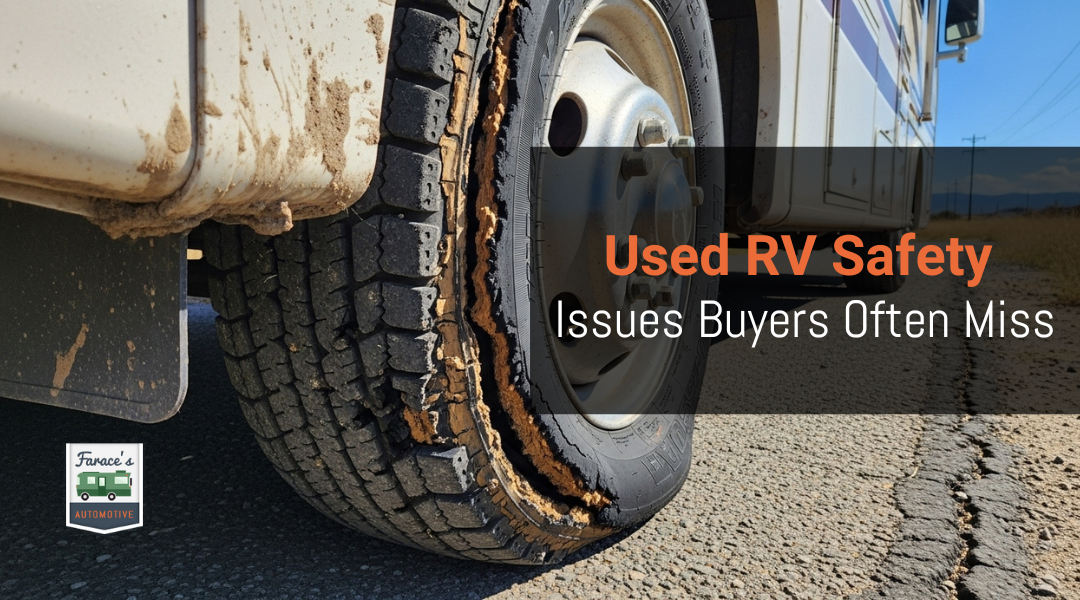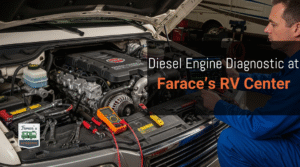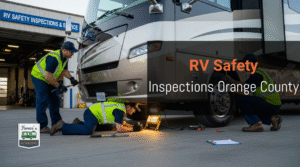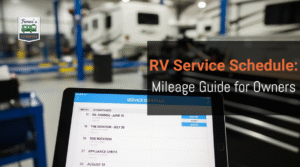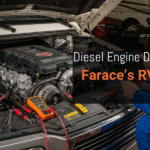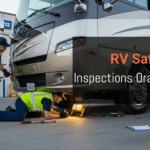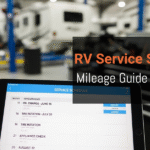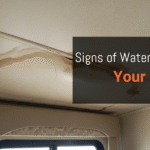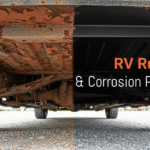Buying a used RV can feel like a smart way to save money, but hidden safety issues often turn that bargain into a costly problem. Many of these risks don’t show up until you’re already on the road, and by then the damage is done. The most overlooked safety issues in used RVs are often tied to electrical systems, propane leaks, worn brakes, and hidden water damage—all problems that can put you and your investment at risk if left unchecked.
You might expect the big issues to stand out, but the reality is that small, unnoticed problems often cause the most trouble. Cracked seals, faulty wiring, or aging tires can slip past a quick walk-through and only reveal themselves under stress. These are the kinds of details that make a thorough inspection more than just routine—it’s essential for protecting both safety and value.
At Farace Automotive & RV Center in Huntington Beach, you get more than a surface look at your RV. With decades of hands-on experience, every inspection focuses on the problem areas that most often go unnoticed. This careful approach ensures you know exactly what you’re buying before you hit the road.
Why Used RVs Require Careful Safety Inspections
When purchasing a used RV, you face risks that are not always visible during a quick walkthrough. Problems with structure, systems, or past repairs can directly affect your safety and the reliability of your vehicle on the road.
The Hidden Risks of Buying Pre-Owned RVs
A used RV can look clean and functional while hiding issues that only appear under close inspection. Water leaks, for example, may not show until heavy rain, but they can lead to mold growth and weakened roof supports. Electrical wiring may also have been altered by a previous owner, creating fire hazards that are not obvious at first glance.
You also need to consider wear on critical components like brakes, tires, and suspension. Even if the RV has low mileage, years of sitting idle can cause rubber parts to crack or metal parts to corrode. These problems may not be visible without removing wheels or inspecting undercarriage areas.
Another overlooked risk is undocumented accident damage. A repaired sidewall or patched roof may look fine cosmetically but could compromise structural integrity. Without a professional inspection, you cannot be sure whether repairs were done correctly or if shortcuts were taken.
How Neglected Maintenance Becomes a Safety Hazard
Many used RVs suffer from inconsistent maintenance because owners often use them only seasonally. Skipped oil changes, ignored brake servicing, or old coolant can all shorten the life of major systems and create safety issues while driving.
Tires are one of the most common hazards. Even if tread looks acceptable, rubber deteriorates with age, and blowouts are a frequent cause of accidents. Checking the DOT date code on each tire helps you confirm its actual age.
Brake systems also require close attention. Worn pads, corroded lines, or low fluid can cause reduced stopping power. Unlike cosmetic flaws, these problems directly affect your ability to control the RV in emergencies.
Neglected seals and gaskets are another concern. A roof or window seal that hasn’t been maintained can allow water intrusion, which weakens flooring and walls. Over time, this damage can make the RV unsafe to drive or live in.
The Most Commonly Overlooked Safety Issues in Used RVs
When you inspect a used RV, many problems are easy to spot, but some safety issues often go unnoticed. These hidden concerns can affect drivability, structural integrity, or even your health if left unaddressed.
Worn or Compromised Brake Systems
Brake systems on used RVs are frequently neglected because wear is not always visible without a detailed inspection. Pads, rotors, and calipers may look intact, but internal corrosion or uneven wear can reduce stopping power.
You should also check the brake fluid. Old fluid absorbs moisture, which lowers braking efficiency and increases the risk of failure under heavy loads. Hydraulic lines can develop small leaks that slowly worsen over time.
For towable RVs, electric trailer brakes often suffer from weak magnets or faulty wiring. Test them with a brake controller to confirm they engage evenly. Even minor braking issues can make a large RV unsafe at highway speeds.
Aging Tires with Hidden Structural Damage
Tires may appear to have plenty of tread, but age and structural wear are bigger concerns. Rubber compounds harden over time, leading to cracks in the sidewalls that can cause blowouts.
Every tire has a DOT date code that shows when it was manufactured. If your tires are more than 5–7 years old, replacement is recommended regardless of tread depth. This is especially important since RVs often sit for long periods, which accelerates dry rot.
Uneven wear patterns, such as one side of the tread wearing faster, often point to suspension or alignment issues. A blowout not only endangers you while driving, but it can also tear into the RV’s body and cause costly damage.
Electrical Wiring and Fuse Panel Defects
Electrical systems in used RVs often show signs of DIY repairs or aging components. Loose connections, undersized wires, and corroded terminals are common problems that can lead to overheating or fire hazards.
Inspect the fuse panel for signs of melted plastic, discoloration, or mismatched fuses. Using a fuse with the wrong rating can allow wiring to overheat without tripping protection.
Pay attention to outlets and extension cords added by previous owners. Non-factory modifications may not meet safety standards. A professional inspection with a multimeter can confirm proper voltage and grounding throughout the system.
Roof Leaks and Water Intrusion Leading to Mold
Roof leaks often start small, but they can cause extensive hidden damage. Cracked sealant around vents, skylights, and seams is usually the first sign. Water intrusion weakens wood framing and insulation, leading to soft spots underfoot.
Moisture trapped inside walls or ceilings can promote mold growth. Mold is not always visible; musty odors or discoloration on interior panels often indicate a problem.
You should climb onto the roof or have a professional do so at least once a year. Regular inspection and resealing are the best ways to prevent costly structural repairs and potential health concerns from mold exposure.
Faulty Propane Systems and Gas Leaks
Propane systems power stoves, furnaces, and refrigerators, but leaks in these systems can create serious hazards. Rubber hoses and fittings degrade with age, and even small leaks can accumulate gas inside the RV.
Check flexible lines for cracks or brittleness. Regulators should be replaced every 10 years, as they lose effectiveness over time. A soapy water solution applied to fittings can reveal leaks by forming bubbles.
You should also verify that propane detectors are installed and working. Unlike natural gas, propane is heavier than air and settles low in the RV, making proper ventilation and detection especially important.
Malfunctioning Emergency Equipment (Smoke & CO Detectors, Fire Extinguishers)
Emergency equipment is often overlooked because it is rarely used until needed. Smoke detectors and carbon monoxide detectors have limited lifespans, usually around 5–7 years. If you see a manufacturing date on the back, replace any unit that is out of date.
Test all detectors before relying on them. Weak or missing batteries are a common issue. CO detectors are particularly important in RVs with propane appliances, as incomplete combustion can release dangerous gases.
Fire extinguishers should also be checked. Many older RVs still carry the original extinguisher, which may no longer hold pressure. A simple pressure gauge reading will confirm if it is still serviceable. Always keep at least one accessible near the exit door.
Why These Issues Often Go Unnoticed
Used RVs often pass from one owner to another without thorough checks. Quick cosmetic updates, skipped inspections, and reliance on surface-level evaluations can hide serious safety problems that only appear after purchase.
Cosmetic Fixes That Mask Bigger Problems
Fresh paint, new flooring, or reupholstered seating can make an RV look well-maintained. However, these updates may cover water damage, structural weakness, or electrical issues that remain unresolved.
For example, replacing wall panels can hide past leaks that weakened insulation or wiring. A patched roof may stop immediate drips but still allow moisture to spread into hidden areas.
You should look beyond cosmetic upgrades by checking for uneven flooring, soft walls, or musty odors. These small signs often point to problems that cosmetic work cannot permanently fix.
Sellers Skipping Professional Pre-Sale Inspections
Many private sellers choose not to pay for a professional inspection before listing an RV. This saves them money and avoids uncovering problems they would otherwise need to repair.
Without a certified evaluation, issues like brake wear, propane leaks, or faulty wiring may never get documented. These are not always visible during a casual walkthrough.
If you are buying, you should confirm whether any inspection records exist. A seller unwilling to provide documentation may be leaving you with hidden repair costs and potential safety hazards.
Buyers Relying on Visual Checks Instead of Diagnostics
It’s common for buyers to walk through an RV, test a few switches, and assume everything works. While this helps spot obvious problems, it misses deeper issues that require diagnostic tools or skilled testing.
For instance, battery health, propane pressure, and appliance performance cannot be confirmed with just a glance. A refrigerator may feel cold during a short visit but fail during extended use.
You should request diagnostic testing or hire a technician to evaluate the RV before finalizing the purchase. Relying only on visual checks increases the chance of overlooking mechanical or safety problems that could lead to expensive repairs later.
How Professional Inspections Protect RV Buyers
A professional RV inspection gives you more than a quick look at the condition of a used motorhome. It evaluates critical systems, uncovers hidden wear, and helps you avoid expensive surprises after purchase.
Comprehensive System Testing Beyond Surface-Level Checks
When you walk through an RV, you may notice cosmetic flaws, but you cannot easily test all mechanical and electrical systems. A professional inspection covers areas most buyers overlook, such as brake performance, generator output, roof integrity, and plumbing lines.
Inspectors use diagnostic tools to measure battery capacity, check for leaks in propane systems, and verify that appliances operate safely. They also examine the chassis, suspension, and steering components for signs of stress or corrosion.
This level of testing ensures you receive a full picture of the RV’s condition. Instead of relying on a seller’s word, you gain documented results that show whether the vehicle is ready for the road or needs repairs.
Identifying Future Problems Before They Become Emergencies
An inspection does more than point out what is broken today. It highlights early warning signs that can lead to costly failures if ignored. For example, small cracks in roof seals may not leak now but could allow water intrusion within months.
Technicians also detect worn belts, hoses, or brake pads that have limited life left. By knowing this in advance, you can plan maintenance instead of being stranded during a trip.
Even minor issues like uneven tire wear or weak batteries can escalate quickly. Identifying them early gives you time to address them on your schedule rather than during an emergency repair.
Saving Money on Repairs and Protecting Your Family’s Safety
Repair costs on RVs often run higher than on passenger vehicles because of the complexity of the systems involved. A professional inspection helps you avoid buying an RV that needs thousands of dollars in hidden repairs.
For example, detecting a failing transmission or water-damaged flooring before purchase can save you from major financial loss. You can also use inspection results to negotiate a fairer price with the seller.
Most importantly, inspections confirm that critical safety systems—brakes, propane lines, fire detectors, and electrical wiring—are functioning properly. This protects not only your investment but also the safety of everyone traveling with you.
The Farace Automotive & RV Center Advantage in Inspections
When you bring in a used RV for inspection, you want more than a quick checklist. You want experienced professionals, reliable tools, and a team that understands the unique conditions of your area. These factors directly impact how well hidden safety issues are identified and corrected.
Over 40 Years of Experience with RV Safety and Repairs
Farace Automotive & RV Center has been serving RV owners since 1976. With over four decades in the industry, the shop has seen nearly every type of repair and inspection issue that can arise. This depth of experience allows technicians to recognize problems that less experienced shops might overlook.
You benefit from a history of working with both older and newer RV models. Whether it’s aging roof seals, worn brake systems, or outdated wiring, the team knows how to spot risks that compromise safety.
Their long-standing presence also means they understand how RVs age over time. Patterns of wear, common failure points, and recurring issues are easier to identify when a shop has tracked them across generations of vehicles.
Certified Technicians and Advanced Diagnostic Equipment
You can expect your RV to be inspected by trained, certified technicians who follow structured processes. Certifications ensure that inspections meet current industry standards and that repairs are completed correctly the first time.
The shop uses diagnostic equipment that goes beyond a visual check. Tools for electrical testing, brake performance measurement, and leak detection help uncover problems that might not be obvious during a standard walk-through.
This combination of skilled technicians and advanced tools reduces the chance of missed safety concerns. For example, a technician can confirm whether a battery system is holding charge properly or if a brake line has hidden weaknesses.
Local Expertise Serving Orange County and Huntington Beach RV Owners
Owning an RV in Southern California comes with specific challenges. High sun exposure, salty coastal air, and seasonal humidity all affect how components wear. Local expertise helps you get inspections that account for these conditions.
Farace Automotive & RV Center has built a reputation among Orange County RV owners for honest service and fair pricing. Many customers value the straightforward approach and the ability to get both inspections and repairs done in one place.
By choosing a shop rooted in Huntington Beach, you gain technicians who know the common issues faced by RVs in the region. This local knowledge ensures that your inspection addresses risks that are most relevant to where and how you travel.

